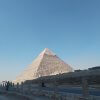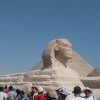- The Egyptian Museum is located in Cairo, in Tahrir Square
- The Egyptian Museum contains more than 120,000 artifacts
- The Egyptian Museum consists of two floors, each floor consists of a group of halls and corridors, each one in which the artifacts of each era of the ancient state are displayed.
- The Egyptian Museum is divided into
- The prehistoric era group: This group includes different types of pottery, decorative tools, hunting tools, and the requirements of daily life, which represent the product of the Egyptian before the knowledge of writing, which settled in many places in Egypt in the north, center and south of the country.
- Foundation era: It includes the effects of the first and second dynasties, such as the Salat of Narmer, the statue of Khasekhemwy, and many utensils and tools.
-
The era of the Old Kingdom: It includes a group of artifacts, the most important of which are the statues of Djoser, Khafre, Menkaure, the Sheikh of the country, the dwarf Seneb, Pii the First, and his son Meri that Ra, and many coffins, statues of individuals, wall pictures, and the Queen Hetepheres collection.
- The Middle Kingdom era: This group includes many artifacts, the most important of which is the statue of King Mentuheb II and a group of statues of some kings of the 12th Dynasty, such as Senusret I, Amenemhat III and others, and many statues of individuals, coffins, ornaments, tools of daily life, and pyramids of some Fayoum pyramids.
- The era of the New Kingdom: It is the most famous group in the museum, headed by the collection of the little pharaoh Tutankhamun, statues of Hatshepsut, Thutmose III and Ramses II, in addition to war chariots, papyri, ornaments, Akhenaten’s collection, the Israel painting, statues of Amenhotep III and his wife T, a set of amulets and writing and agricultural tools, then a group of royal mummies that are displayed In its own hall, which opened in 1994, until the royal mummies were transferred to the National Museum of Egyptian Civilization in Fustat as part of the royal mummies procession event in 2021.
- Late Ages: The collection includes various artifacts, including the treasures of Tanis made of gold, silver, and precious stones, which were found in the tombs of some kings and queens of the 21st and 22nd families in San al-Hajar, in addition to some important statues such as the statue of Amun, Mentumhat, a statue of the goddess Tawert, and the Canopus decision board ( Abu Qir) and the painting of Ankhi and a group of Nubian antiquities, some of which were transferred to





